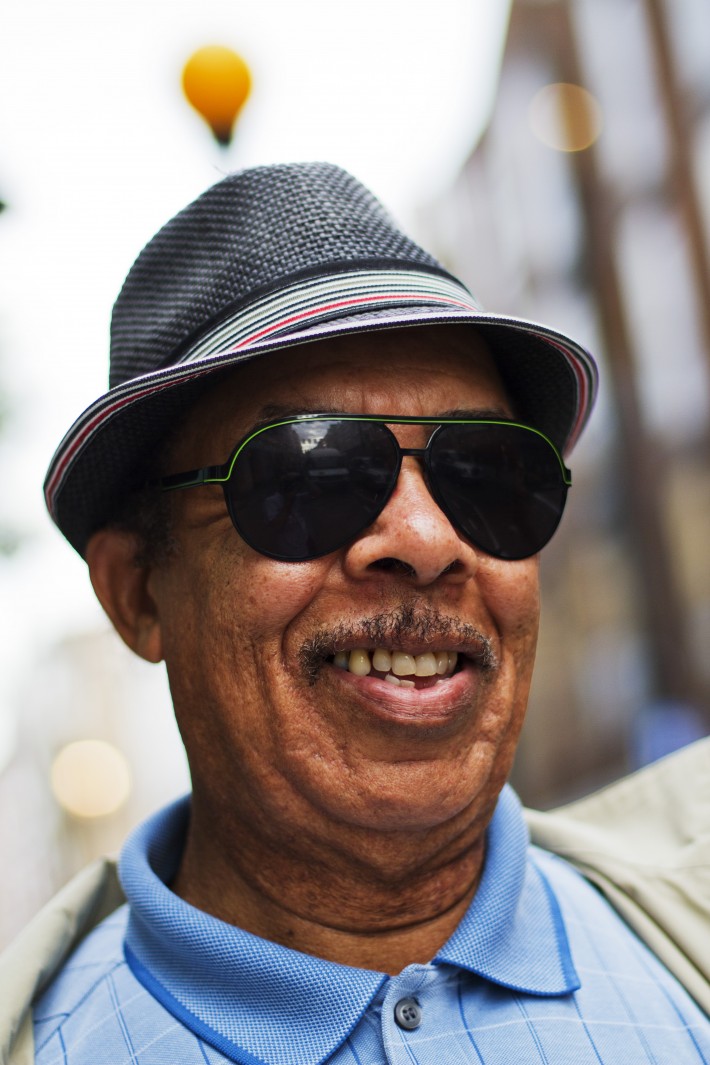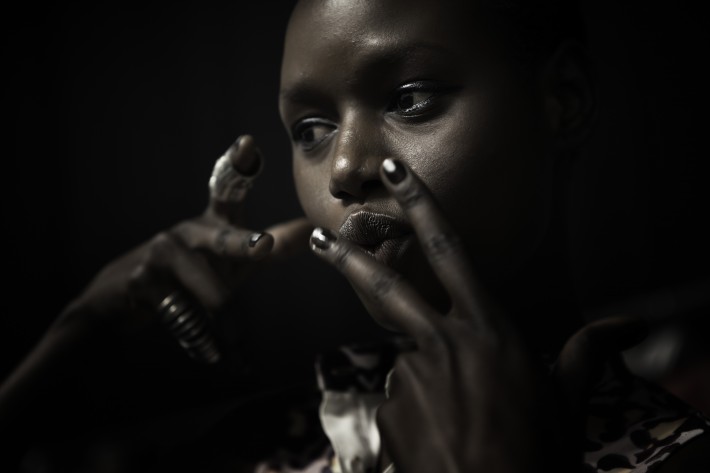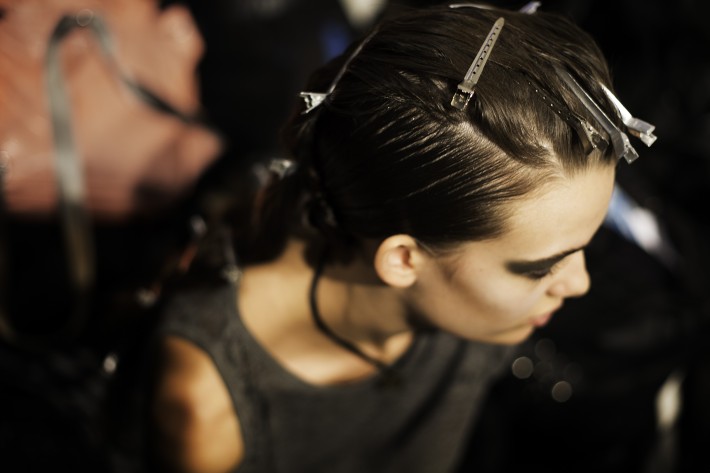Because most of us fear rejection to some degree, speaking to a complete stranger and asking them for something, let alone asking if you can photograph them, tends to be pretty challenging. I’ve never been one of those naturally confident people but over time I’ve developed some techniques that have provided me with the confidence to work with strangers, which has brought additional benefit when communicating with paying clients.
I'll outline 15 simple tips which have helped provide a decent platform for exploring candid portrait photography. All the photographs featured are from a brief 20 second or less interaction with complete strangers.
If you enjoy making portraits or are a working portrait photographer, I thoroughly recommend making time to get out of the studio and your comfort zone and make some candid shots of random strangers. Personally, I find it one of the most exciting and rewarding parts of what it means to really make a photograph. I believe having to improvise and interact with strangers on the fly and utilizing whatever gear or natural light you have, will help build your skill set. It's also a great way to help build confidence and communication skills, and might even give you some new inspiration for what you can do in the studio, or how you communicate with clients and subjects.

1. Approach is Critical
Try not to jump out or make sudden movements when you get close to someone you'd like to photograph, and avoid talking to them from the back or side. Wait until you are in front and can make eye contact with them to reduce the chances of startling them.
2. Get Your “Elevator Pitch” Perfected
My patter usually ran along the lines of “Hi, I’m sorry to bother you , I’m a photographer, I really like how ………….. (insert whatever intrigued you about them in the first place here), would you mind if I took 15 seconds of your time to photograph you?" Starting with a nice compliment on what is interesting about them or their look is a also good ice breaker (see #6 below).

3. Be Honest
If they ask you “What are the photographs for?”, tell the truth. If you are shooting for anything other than for fun and your own portfolio, be clear about who you are shooting for and the nature of the project. Assessing body language and what they say is critical – if they appear reluctant, don’t get nervous, just remind them that if they don’t like the shot, you can delete it after reviewing on the LCD. Most of the time, people like the image and actually ask for a copy anyway. If you think the image might be used elsewhere, it’s a good idea to ask them to sign a model release anyway. There are a few apps such as Easy Release for iOS and Android that allow you to get releases signed quickly on your smart phone or tablet.
4. Dress for Success
Blending in is important. I usually leave my gear bag at home and carry a few lenses and one body. Try to dress for the area/type of person you might be shooting. It helps not having two large camera bodies with long lens swinging from your shoulders or excessive amounts of gear as too much of that stuff can intimidate people, not to mention being a burden to carry around. The idea is to be relatively minimal and just work fast and efficiently.

5. Be Familiar With Camera Settings
Be confident you can change settings quickly and without looking at the buttons. No one wants to stop, pose for a shot, and then stare at you as you fiddle with dials and press buttons. I will usually set my aperture, shutter and ISO based on what settings I think I need, or on what I want to achieve with the shot, and then make more incremental adjustments as needed. Shooting in Aperture Priority mode can also help save time, as you only have to think about your depth of field.
6. Pay Them A Compliment
Take some shots, put the camera down for a second, move a little and compliment them or their appearance or whatever looks interesting to you. This will help relax them and gives you the opportunity to then quickly pull the camera up and get some nice shots while they are relaxed. It will also help them feel like they are part of a creative collaboration, rather than you just taking something from them.

7. Give Direction
Don’t be afraid to say “I’d like you to look straight into the camera or could you move your right arm slightly” or something similar. Direction is essential to enable you to get an image that is as close as possible to your vision. It’s a balance though; too much directing might make them feel uncomfortable or annoyed. It’s a fine balance but it’s great practice to learn how to give good, succinct direction to subjects.
8. Move
Shoot some full length, three quarters and close ups. Movement gives you a range of images. Small angle changes can present very different perspectives. Experiment.

9. Don’t ‘Chimp’
Don’t review each shot you take on the LCD. You want to be as efficient as possible with your subject’s time (see #5 above). Check the first shot on the screen, adjust settings if needed, and check once more before taking a few more shots. If adjusting is taking longer, talk a little to keep them relaxed. Try not keep anyone more than 15-30 seconds. If you value their time, people will probably be willing to give more of it to you.
10. Pick Subjects Strategically
This is an obvious one perhaps, but someone walking at a very fast pace while screaming into their phone probably isn’t the best person to approach, no matter how compelling a photograph of them might be.
11. Just Hang Out
Aim for an area that has high foot traffic, pick a background you think will work (something that is not distracting) and stop targets as they a walking by. I heard that Cartier-Bresson once waited in a stairwell for 3 hours to get his famous image of the cyclist passing by. If you like a scene and have time, hang out and just observe.

12. Be Gracious and Smile
When strangers stop and allow us to photograph them, they give us the most precious of commodities (their time), and they usually enjoy the brief opportunity to collaborate on something fun and creative. I always smile, thank them and offer a business card/portfolio link/general conversation if they ask any questions. If your subject is interested, show them the LCD shots rather than just dashing off. Small details can easily leave someone feeling great for the rest of the day.
13. Maintain Momentum
Once you’ve shot someone, avoid the temptation to go around the corner and start to review the images. Use that positive experience and energy to scout the next subject. If you get a rejection, it’s critical to find and engage your next subject even more quickly as you don’t want to dwell on being knocked back. Getting ‘back on the bike’ if you fall off like this is really important.

14. Remember – This is Fun!
Going up to someone on the street is stressful. But do it enough and I guarantee it becomes a lot easier. You’ll find yourself becoming more and more confident and this makes the whole process a virtuous cycle of success. The more confidence you have, the more likely you are to get a good rapport going, which means a higher chance of people saying yes and trusting you, building more confidence. Even if you get knock backs, you are doing this because you enjoy the challenge of making great photographs. Try to enjoy the process, it can be very rewarding once you embrace it.
15. Apply Your New Skills
I take all the experience of shooting strangers to New York Fashion Week where I tend to have to work very quickly with complete strangers to try and capture compelling images behind the scenes. Fashion Week is ending today, but I’ve included a selection of images from previous Fashion Week events to try to show a connection between how I apply the work on the street with strangers to other facets of what I might end up shooting. I guarantee those of you that make portraits or work with people will find shooting with strangers a great way to leverage new skills and experience that you can take to paying clients.











Hope this is useful food for thought. I would love to hear how you started photographing strangers. If you have your own tips on connecting with people quickly before you photograph them, please feel free to share with the community in the comments below.







Very good points. I'm 91 strangers into my 100 Strangers project. I definitely agree with 1) Less gear is more 2) Dress to fit into the setting 3) Smile. I also give my business card to them with my email and say I'd be happy to send them their photo (very few ever reach out though). I try to chat with them for a bit too, to get the basics (name, age, where from). Everyone has a good story.
My courage to approach strangers ebbs and flows but I hope to finish the project soon. Here's a link to my images: http://bit.ly/1d6mchr
~ Mark
great post
thanks, glad you liked it :)
nice post
Thanks DD
Great post. I've always wanted to do this just never had the courage or game plan. Might try it now.
Thanks Jacob, go for it, it's a great challenge to get out of our comfort zone
Thank you. (self- remember to smile)
Welcome :)
Ha! Good Photos, I especially like the last one with the finger nails!
Thanks Joey
Love!!
Bloody great!!
Great advice, and great shots! :)
Thanks Bob, appreciate that
I spent a day in Camden doing this not so long ago, was daunting at first but i was surprised about how many people were willing to pose and interact.
what a great post.
thanks CW
All last year, I started taking portraits of people I came across. At first, it was really hard to work up the courage to approach them, but after a few, I really enjoyed the experience. I met so many awesome people and shared great conversation. I recommend everyone trying it at some point.
If anyone wants to see more, here is a link to more pictures from this project:
http://denniswetzelphotography.com/index2.php#/rgallery2/1/
nice work dude!
Thanks so much! Great article too!
what mm lens did you use on the interior design shots? 35?
Hey Alex, I believe it was the Canon 16-35mm 2.8.
I was out a few months ago working on a project on beach culture and I approached a couple making jewelry near the boardwalk. They looked really approachable and friendly. I said, "hey would you mind if I just got a couple quick photos of you two? I'm working on a photoessay." The girl responded to me, "Uh, well we... uh usually get paid for that kind of stuff..." I replied jokingly, "yeah me too!" Then I smiled, said thank you, and walked away. I felt INCREDIBLY discouraged after that. But I went up to another person later (who actually looked very unapproachable) and got a completely different response. They were excited about my project, happy to help, and loved the results. My point is that it's also good to keep in mind that you never know how someone will respond based on what they look like, their attitude/vibe, what their wearing etc. If you're interested in photographing someone, you might as well just go up and ask them, you have nothing to lose!
I'm 270 people into my strangers project. It is a great social exercise as well as a photographic one.http://www.flickr.com/photos/neilwinch/sets/72157625966833467/
I'm just starting in the photography world and this kind of tutorials are extremelly helpfull.
thanks!!!! :D
...luv love xx
Totally agree with the comments - followed a lot of them in this shoot - www.creatographylabs.com/city-contrasts/
Great article!